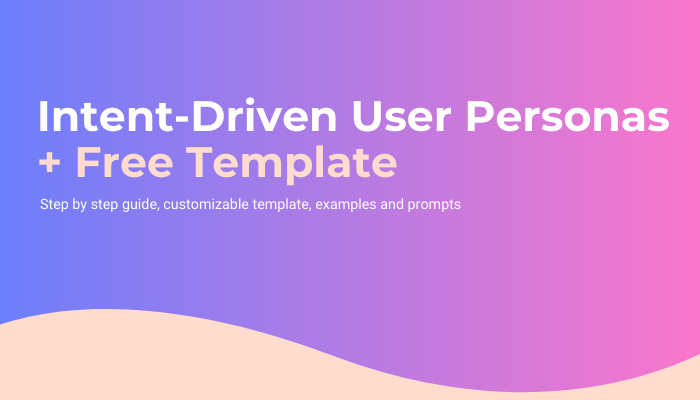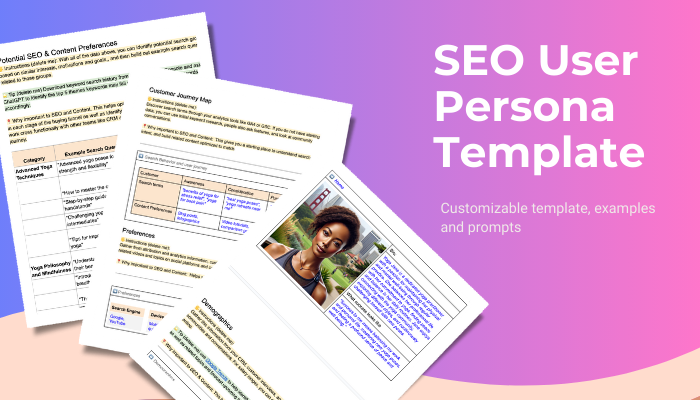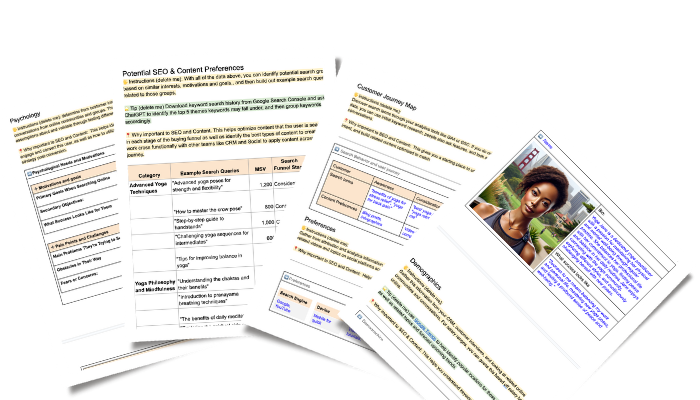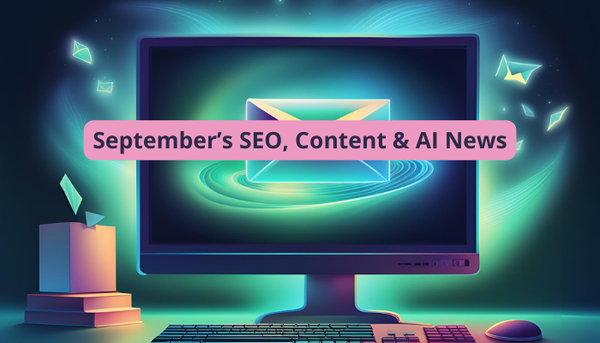Boost SEO with Intent-Driven Personas + Free Template
Explore how to develop SEO-focused user personas and how to use them to enhance your keyword research, content creation, and overall optimization efforts. Download a free template you can use to craft your personas today.

Explore how to develop SEO-focused user personas and how to use them to enhance your keyword research, content creation, and overall optimization efforts. Download a free template you can use to craft your personas today.
What's Included:
Today I want to discuss user personas for SEO - a valuable way to take your SEO driven content to the next level. While user personas are typically created by marketing strategists, SEO professionals can benefit from being involved in their creation. An SEO-centric user persona should consider search behavior, search intent, and the type of content users are looking for. By understanding these aspects, SEOs can optimize websites and content to improve search engine rankings.
With AI-driven advancements like Google's AI Overviews, understanding user intent and potential follow-up questions is crucial during keyword research and content creation. This is where user personas can be invaluable. Detailed profiles of ideal customers offer insights into their search motivations. By understanding the "why" behind their queries, SEO strategies can be tailored to directly address their needs and improve the chances of ranking highly for their query or obtaining an AI overview or Featured Snippet.
In this post, I will discuss the importance of user personas for modern SEO. Let's explore how personas can guide keyword research, content creation, and overall optimization efforts, along with practical tips for developing accurate personas and leveraging them to connect with the audience on a deeper level. Ready?

Free subscribers get access to the complete template with tips, AI prompts and instructions!
Understanding User Personas:
For those unfamiliar, user personas are fictional representations of ideal customers based on real data and insights into their behaviors, goals, and pain points. By empathizing with the target audience, content can be created to resonate with them and websites can be optimized to meet their needs.
By creating detailed user personas, you can better understand what makes your customers tick. What drives their purchasing decisions? What challenges are they facing in their lives or jobs? What do they value most in the products or services they use? Answering these questions helps you develop a deep empathy for your target audience
Let’s dive deeper into the “what” and “why” behind search behavior. User personas can help you identify the three main types of search intent:
- Informational Queries: These are the "how-to," "what is," and "why" questions that dominate the search landscape. Think of someone desperately googling "fix leaky faucet" or "best hiking trails Yosemite." Their intent is clear: they're seeking information to solve a problem or answer a question.
- Transactional Queries: Here, users are ready to take action. They might search for "buy hiking boots online" or "restaurants near me with outdoor seating." Their intent is to make a purchase or complete a transaction.
- Navigational Queries: These queries are all about finding a specific website. Someone searching for "[company name] support page" or "[brand name] official website" already knows where they want to go. Their intent is simply to navigate to a particular website.
User personas help you see your customers as real people with real needs and desires, not just abstract data points. They allow you to step into your customers' shoes and view your business from their perspective
By understanding the user's intent through user personas, you can tailor your SEO strategy accordingly. For informational queries, creating high-quality content that addresses their specific questions is what will help acquire initial traffic and brand awareness. For transactional queries, optimizing product pages and conversion funnels helps SEO contribute to revenue based objectives. And for navigational queries, ensuring your website is easily discoverable through clear branding and a focus on relevant keywords is key.
The Benefits of Using User Personas in Marketing and SEO
Developing user personas offers tangible benefits for your marketing and SEO efforts. Here are some of the key advantages:
🔑 Targeted Keyword Research
User personas can guide your keyword research by helping you identify the terms and phrases your ideal customers are using to search for products or services like yours. By understanding their goals and pain points, you can focus on keywords that align with their needs and intentions.
For example, if one of your user personas is a busy working parent looking for quick and healthy meal options, you might target search queries like "easy weeknight dinners" or "healthy meal prep ideas." These queries reflect the specific challenges and desires of that persona.
📄 More Relevant and Engaging Content
When you have a deep understanding of your user personas, you can create content that speaks directly to their needs and interests, which will help to naturally match keywords in your content to their intent. Whether you're writing blog posts, crafting product descriptions, or drafting social media posts, you can tailor your messaging to address the specific pain points and goals of each persona.
For instance, if one of your user personas is interested in sustainable fashion, you could create content that highlights the eco-friendly materials and ethical production methods used in your clothing line. By speaking to the values and priorities of that persona, you can create content that truly resonates.
⚙️ Improved User Experience
Part of Google’s algorithm leak revealed that user engagement metrics on a site are considered when ranking websites, or determining whether an answer should show in AI Overviews. If you don't have a great user experience, you are not only missing out on valuable search visibility but also missing out on engaging and converting your traffic.
User personas can also inform the design and functionality of your website or product. By understanding how your ideal customers navigate your site, what information they're looking for, and what features are most important to them, you can create a user experience that is intuitive and enjoyable.
Let's say one of your user personas is an older adult who is less comfortable with technology. In that case, you might prioritize simplicity and clarity in your site design, with easy-to-read fonts, straightforward navigation, and helpful tooltips or tutorials.
📈 Enhanced Conversion Rates
Ultimately, the goal of using user personas is to create marketing strategies that drive conversions and revenue. By tailoring your messaging, content, and user experience to the specific needs and preferences of your ideal customers, you can increase the likelihood that they will take the desired action, whether that's making a purchase, signing up for a newsletter, or booking a consultation.
Using personas to identify the key intent behind search queries:
SEO is no longer about optimizing for specific keywords. It's about understanding the underlying goal the user hopes to achieve with their search. Your detailed user personas hold the key to unlocking those core intentions:
👉 Review your personas' pain points, challenges and aspirations. What questions are they likely typing into search engines to find solutions? Those queries reveal their intent.
👉 Map out the customer journey for each persona. What information are they searching for at each stage, from initial awareness to final purchase decision? The intent behind their searches evolves along this journey.
👉 Analyze the language and terminology your personas use. Do they search with technical jargon or layman's terms? Understanding their vocabulary helps you infer intent.
👉 Consider your personas' roles and level of knowledge. Are they looking for high-level overviews or in-depth, tactical advice? Executives and practitioners often have different intentions.
By viewing search behavior through the lens of your target personas, you can go beyond surface-level keywords to uncover the deeper intents driving those queries. This empowers you to create content that truly resonates.
Tailoring content to match the needs, goals, and preferences of your target personas
Armed with an understanding of user intent, you can now optimize your content to align with the specific needs of your personas at each stage:
- Satisfy informational intent by creating comprehensive guides, tutorials, and resources that address your personas' questions and knowledge gaps. Become their go-to source for expertise.
- For commercial intent, provide detailed product guides, comparison charts, and case studies featuring customers similar to your target persona. Help them feel confident in their purchase decision.
- Cater to transactional intent with landing pages optimized for conversion, featuring prominent calls-to-action, trust signals, and content that overcomes common objections for each persona.
- Optimize around navigational intent. Make it easy for returning visitors to find their way back to key pages on your site by optimizing for branded keywords they're likely to search.
- Dont forget retention! Before customers churn or cancel they often indicate their dissatisfaction with their search intent. You can utilize SEO to create resources that enhance satisfaction and precent customer churn.
Beyond just the topic and angle of your content, consider the content format and depth that will resonate best with each persona:
🧩 Busy executives may prefer skimmable articles with key takeaways highlighted, while detail-oriented managers may appreciate in-depth ultimate guides.
🧩 Visual learners will engage with infographics and videos, while analytical personas may prefer data-driven whitepapers and research reports.
🧩 Some personas may favor short-form content they can quickly consume, while others will invest the time to read pillar pages and long-form guides that dive deep into a topic.
By tailoring your content strategy to match the intent-driven needs and preferences of your target personas, you'll attract more qualified traffic and engage visitors more effectively. You'll build trust and thought leadership with your ideal audience.
Ultimately, user personas and search intent are two sides of the same coin. Integrate both into your SEO approach to create customer-centric content that drives results. Adapt this intent-based mindset and you'll be well-positioned to outperform competitors still stuck in the keyword-stuffing past.
Optimizing Content Structure and Format Based on User Intent
There’s a saying that “it's more important how you say something, than what you say.” The structure and format of your content can be just as crucial as the information itself when it comes to satisfying user intent and keeping readers engaged.

One advanced technique is to analyze the content types and formats that are already ranking well for your target keywords. Are the top results mostly long-form guides, or do they include a mix of list posts, videos, and interactive tools? By understanding what Google has already determined to be the most relevant format for a given query, you can adapt your own content structure accordingly.
For example, if you're targeting a keyword with informational intent like "how to train for a marathon," and the top results are primarily step-by-step guides with detailed subheadings, you'd want to mirror that structure in your own post. On the other hand, if you're going after a commercial investigation keyword like "best CRM software," and the SERP features a mix of product roundups, comparison tables, and video demos, you might opt for a more visual and interactive format.
But optimizing content structure goes beyond just matching what's already out there. You can also use your understanding of user intent to anticipate the logical next steps in your reader's journey and build that into your content hierarchy.
For instance, if someone is searching for "how to choose a yoga mat," they might also be interested in the yoga mat thickness, comparisons of top yoga mat brands, or tips for cleaning and maintaining their mat. By structuring your content to address these related subtopics and linking to relevant resources, you keep readers on your site longer and establish your brand as a comprehensive resource.
The key is to always put yourself in your audience's shoes and consider how the structure and presentation of your content can best serve their needs at each stage of their journey. Whether that means using jump links for easy navigation, embedding relevant videos or infographics, or experimenting with interactive elements like quizzes and calculators, the right format can be a game-changer for user engagement and SEO performance.
Utilizing User Personas for More Effective Keyword Research
While many marketers use personas to guide their content strategy and messaging, fewer realize the potential of personas to inform and enhance keyword research. By deeply understanding your target audience's goals, challenges, and language, you can uncover valuable keyword opportunities that might otherwise be missed.
You can map your target keywords to specific stages of your user personas' buying journeys. Using the yoga example, someone in the early awareness stage might search for broad terms like "how to develop a yoga routine" while someone further along in the consideration stage might use more specific phrases like "online yoga groups."
By categorizing your keywords based on persona and funnel stage, you can prioritize your content creation efforts and ensure that you're targeting the right terms for each segment of your audience.
Another persona-driven keyword research tactic is to mine online communities and forums where your target audience is active. By analyzing the language and topics that come up most frequently in these discussions, you can identify long-tail keyword opportunities and get a better sense of the questions and concerns that are top-of-mind for your personas.
Let’s take the yoga example further and look at the Yoga subreddit. Here we can see there are often questions around traveling with a yoga mat


Create a PDF of the main page of any subreddit, then upload it to Chat GPT and have it analyze common questions, themes and language used.
You can then create a section on your website around travel-friendly yoga mats and then write an article answering questions like “can I check a yoga mat on an airplane” and link to your travel-friendly collection.
You can also use persona data to refine your keyword qualification process. Rather than just relying on search volume and difficulty scores, consider factors like commercial intent, relevance to your persona's needs, and alignment with your brand voice. A keyword might have high search volume but attract the wrong audience for your business.
Ultimately, the key to persona-driven keyword research is to constantly put yourself in your audience's shoes. What questions are they asking at each stage of their journey? What language do they use to describe their challenges and goals? By allowing these insights to guide your keyword discovery and prioritization, you can create content that truly resonates with your target market.
Applying User Personas to Guide Link Building Strategies
Link building is often seen as a numbers game, with marketers focused on acquiring as many links as possible from high-authority domains. But as with keyword research, taking a persona-driven approach to link building can help you attract links that are not only valuable for SEO, but also highly relevant to your target audience.
One advanced tactic is to use your user personas to identify niche influencers and thought leaders who have the ear of your target market. Rather than just chasing links from big-name publications, consider partnering with bloggers, podcasters, or social media personalities who specialize in topics that are top-of-mind for your personas.
Using the yoga example, if you were to find you got decent search or conversions around these terms, you might find that collaborating with a travel blogger or Instagram influencers in minimalism could be a powerful way to earn links and exposure with that audience.
Another persona-driven link building approach is to create content assets that are specifically designed to appeal to the needs and interests of your target personas. Rather than just churning out generic blog posts and infographics, consider developing niche resources like industry reports, case studies, or interactive tools that provide unique value to your audience.
By tailoring your content to the specific pain points and aspirations of your personas, you increase the likelihood that other sites will want to link to it as a valuable resource for their own audiences.
You can also use persona insights to personalize your link building outreach. Rather than sending generic link requests, take the time to research the sites and influencers you're reaching out to and craft your pitch around how your content can benefit their specific audience.
For example, if one of your personas is a busy mom who loves yoga and you're reaching out to a parenting blogger to promote your guide on "how to yoga with children" you might highlight specific sections or tips that would be most relevant to their readers, based on your understanding of that persona.
The key to persona-driven link building is to always prioritize relevance and value over sheer volume. By earning links from sites and influencers that truly matter to your target audience, you not only boost your SEO performance but also build brand awareness and credibility with the people who are most likely to become your customers.
Best Practices for Developing User Personas for SEO
Let's explore some advanced techniques and best practices for crafting highly effective user personas and take our persona creation to the next level.
Conducting User Research and Surveys to Gather Persona Data
Traditional user research methods like surveys and interviews remain essential, there are some more techniques that can help you uncover deeper insights:
Conduct "day in the life" studies: Go beyond basic demographic questions and ask your survey or interview participants to walk you through a typical day in their life. What challenges do they face? What motivates them? What information do they seek out? These contextual insights can help you create more vivid and relatable personas.
Employ projective techniques: In your user research, consider using projective techniques like word association, sentence completion, or storytelling. These methods can help uncover subconscious attitudes and emotions that participants may struggle to articulate directly. For example, ask them to describe their ideal online experience as if they were explaining it to a friend.
Analyzing Website and Search Analytics to Inform Persona Creation
Your website and search analytics hold a wealth of information about your target audience's behavior and preferences. Here are some advanced techniques for mining those insights:
👀 Segment by user journey stage: Go beyond basic demographic segmentation and analyze your analytics based on where users are in their buyer's journey. What pages and content do users engage with when they're in the awareness stage versus the consideration or decision stage? These insights can help you create more nuanced personas based on their information needs at each stage.
👀 Identify "power users": Look for patterns in your analytics that indicate highly engaged users. These could be visitors who spend significant time on your site, visit frequently, or convert at a higher rate. Analyze the characteristics and behavior of these "power users" to inform your persona development. What sets them apart from more casual visitors?
👀 Employ AI-powered analytics tools: Google Analytics 4 now offers AI-powered insights and predictions. Leverage these tools to uncover patterns and segments you may have overlooked. For example, GA4's "Insights" feature can automatically surface unusual trends or high-performing segments. Use these insights to refine your personas or identify new ones.
👀 Create "negative personas": In addition to your ideal customer personas, consider creating "negative personas" based on your analytics. These represent visitor segments that may not be a good fit for your business, such as job seekers, students, or users with very low engagement. By identifying these negative personas, you can better focus your SEO efforts on attracting your ideal audience.
👀 Analyze search intent: Dive deeper into the search queries driving traffic to your site. SEO tools like Ahrefs or Semrush allow you to group queries by intent - informational, navigational, transactional, or commercial investigation. Understanding the intent behind your target audience's searches can help you create more accurate and actionable personas.
By combining these advanced user research and analytics techniques, you can develop rich, multidimensional user personas that go beyond surface-level demographics. These personas will not only guide your SEO keyword and content strategies but also help you craft more compelling and persuasive marketing messages across all channels.
Remember, persona development is an ongoing process. As your business and audience evolve, continue to refine and update your personas based on new data and insights. By staying attuned to your target audience's changing needs and preferences, you can ensure your SEO strategy remains relevant and effective over time.
Incorporating demographic, psychographic, and behavioral attributes
While age, gender, and location provide a foundation, incorporating psychographic and behavioral attributes is essential for gaining a deeper understanding of your target audience.
Behavioral attributes, such as purchase history, website interactions, and customer service inquiries, provide valuable insights into how your audience engages with your brand.
By analyzing past purchase data, you might uncover that a specific persona tends to buy your products as gifts during the holiday season. Armed with this knowledge, you can create targeted campaigns with gift-giving themes and promotions to capitalize on this behavioral trend.
The key is to use AI to unify demographic, psychographic, and behavioral data into comprehensive, data-driven personas.
Creating Multiple Personas to Represent Different Segments of Your Target Audience
While it's tempting to create a single, all-encompassing persona, the reality is that your target audience likely consists of multiple distinct segments, each with their own unique characteristics, needs, and preferences. In our yoga example, you might find that you are catering to an audience that loves to participate in yoga activities, while another persona may be a certified Yoga teacher who will have different search intents.
By developing multiple personas, you can ensure that your marketing efforts are tailored to the specific nuances of each segment.
Creating User Personas for SEO: A Step-by-Step Guide
Here is a step by step guide to creating a user persona for SEO
- Gather Data
- Analyze your website analytics (e.g., Google Analytics or Google Search Console) for demographic information, behavior patterns, and popular content.
- Conduct user surveys where possible to acquire more information, and review surveys conducted in the past.
- Use social listening tools or browse online communities to uncover deeper insights.
- Look at people also ask queries to see what type of follow-up questions exist around identified top keywords
- Look at Google trends around your topic to uncover data like locations, similar topics and more.
- Identify Common Characteristics
- Look for patterns in the data you've collected. Use AI to help with this by uploading documents and requesting help to analyze.
- Define Core Personas
- Create 2-4 distinct personas based on your findings. For example, Yoga Instructors and Yoga Students.
- Outline SEO-Specific Details
- Determine the search intent for each persona (informational, navigational, transactional).
- Describe Goals and Pain Points
- Define what each persona is trying to achieve when they come to your site.
- Map the User Journey
- Outline the typical path each persona takes from initial search to conversion.
- Determine Preferred Channels
- List the platforms and devices each persona uses most frequently.
- Create Persona Documents
- Compile all the information into a clear, easy-to-reference document for each persona.
- Align SEO Strategy with Personas
- Use the persona information to guide keyword research and content creation.
- Regularly Update and Refine
- Review and update your personas periodically (e.g., every 6-12 months).
By following these steps, you'll create detailed user personas that can significantly enhance your SEO efforts, ensuring your content and optimization strategies are aligned with your target audience's needs and behaviors.
SEO User Persona Template and Example
Here is an example user persona template I created, using our recurring Yoga theme in the article. I have included the examples within the template so you can see how they are utilized. I also listed instructions and relevant AI prompts to help your persona creation efforts:





